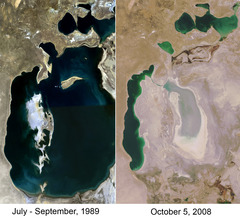It was once the fourth-largest lake in the world. But not any longer. The lake is located on the border between Kazakhstan and Uzbekistan. NASA released satellite images that show half of the lake is nearly dry.
In a release NASA stated,
“For the first time in modern history, the eastern basin of the South Aral Sea has completely dried.”
Video Of Lake Aral’s Dust Storms Turning The Area Toxic:
The problem is man-made. In the 1960’s the former Soviet Union decided to start,
“Diverting the Aral Sea’s snowmelt-fed water from the Syr Darya and Amu Darya rivers to irrigate the desert farms of Kazakhstan, Uzbekistan, and Turkmenistan.”
When NASA first took satellite images in 2000, the lake was divided into two completely separate lake, the Northern Aral Sea and the Southern Aral Sea. In attempt to save the north half of the lake, Kazakhstan built the emergency dam project in 2005. But that ended up completely draining the south sea.
The great sea used to produce 40,000 tons of fish per year, but that industry was nearly dead in the early 1980’s.
The loss of water has wreaked havoc on the local community and climate NASA notes:
As the lake dried up, fisheries and the communities that depended on them collapsed. The increasingly salty water became polluted with fertilizer and pesticides. The blowing dust from the exposed lakebed, contaminated with agricultural chemicals, became a public health hazard.
The salty dust blew off the lakebed and settled onto fields, degrading the soil. Croplands had to be flushed with larger and larger volumes of river water. The loss of the moderating influence of such a large body of water made winters colder and summers hotter and drier.
A four-year drought, less snow in the Pamir Mountains and climate change are dealing the final blows to this great lake.
NASA scientists warned that “complete desiccation” of the sea “could happen in as few as 15 years.”
That was in 2003. We are almost there.





